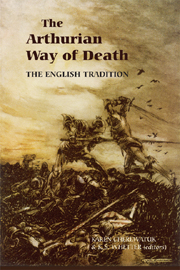Book contents
- Frontmatter
- Contents
- Illustrations and Tables
- Dedication
- List of Contributors
- Introduction
- Part I The early Tradition in england
- Part II Middle English Romance and Malory
- Part III Medieval Influence and Modern Arthuriana
- 10 Arthurian Exits: Alone, Together, or None of the Above
- 11 Woman as Agent of Death in Tennyson's Idylls of the King
- 12 Death as ‘Neglect of Duty’ in Howard Pyle's The Story of the Grail and the Passing of Arthur
- 13 Death and the ‘grimly voice“ in David Jones's In Parenthesis
- 14 Roll the Final Credits: Some Notes on Cinematic Depictions of the Death of Arthur
- Index
- Arthurian Studies
12 - Death as ‘Neglect of Duty’ in Howard Pyle's The Story of the Grail and the Passing of Arthur
from Part III - Medieval Influence and Modern Arthuriana
Published online by Cambridge University Press: 12 September 2012
- Frontmatter
- Contents
- Illustrations and Tables
- Dedication
- List of Contributors
- Introduction
- Part I The early Tradition in england
- Part II Middle English Romance and Malory
- Part III Medieval Influence and Modern Arthuriana
- 10 Arthurian Exits: Alone, Together, or None of the Above
- 11 Woman as Agent of Death in Tennyson's Idylls of the King
- 12 Death as ‘Neglect of Duty’ in Howard Pyle's The Story of the Grail and the Passing of Arthur
- 13 Death and the ‘grimly voice“ in David Jones's In Parenthesis
- 14 Roll the Final Credits: Some Notes on Cinematic Depictions of the Death of Arthur
- Index
- Arthurian Studies
Summary
No one really cares for death, but in medieval literature death is tenaciously reconfigured as an entrance into eternal life rather than an exit from this life. In Howard Pyle's early twentieth-century American version of the rise and fall of the Round Table, based chiefly on Sir Thomas Malory's Morte Darthur, death is not easily sublimated. The ascetic, and arguably peaceful deaths of Lancelot and Guinevere narrated in the Morte do not mesh smoothly with the masculine tale of duty Pyle has fashioned out of the Arthurian tradition for an American middle-class boy reader.
Writing Arthurian literature was as popular in America as in Britain in the nineteenth century, and, as in Britain, was prompted largely by Tennyson's Idylls of the King and his source, Malory's Morte Darthur. In America, the Idylls inspired both emulation and ridicule, the latter found most famously in Mark Twain's A Connecticut Yankee in King Arthur's Court. Howard Pyle moved in artistic and literary circles that regularly produced medievalist art and fiction, a community that included Mark Twain and Edwin Abbey among others. Pyle became widely known as an author and illustrator for children with his hugely popular Merry Adventures of Robin Hood (1880). In his prolific career, he wrote further novels set in the Middle Ages and illustrated medieval fiction written by others before embarking on his comprehensive Arthuriad.
Pyle's four-book Arthuriad, published sequentially between 1903 and 1910, is the culmination of the nineteenth-century spate of retellings of Malory's Morte for children that idealized chivalric heroes as exemplary models for boys.
- Type
- Chapter
- Information
- The Arthurian Way of DeathThe English Tradition, pp. 206 - 225Publisher: Boydell & BrewerPrint publication year: 2009



